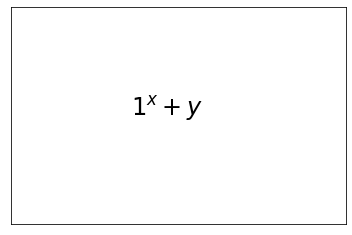Here's a rather long but still incomplete method that doesn't involve sympy in any way. It's enough to cover the example of (-b-sqrt(b**2-4*a*c))/(2*a) which gets translated to \frac{- b - \sqrt{b^{2} - 4 \; a \; c}}{2 \; a} and renders as
![alt text]()
It basically creates the AST and walks it producing the latex math the corresponds to the AST nodes. What's there should give enough of an idea how to extend it in the places it's lacking.
import ast
class LatexVisitor(ast.NodeVisitor):
def prec(self, n):
return getattr(self, 'prec_'+n.__class__.__name__, getattr(self, 'generic_prec'))(n)
def visit_Call(self, n):
func = self.visit(n.func)
args = ', '.join(map(self.visit, n.args))
if func == 'sqrt':
return '\sqrt{%s}' % args
else:
return r'\operatorname{%s}\left(%s\right)' % (func, args)
def prec_Call(self, n):
return 1000
def visit_Name(self, n):
return n.id
def prec_Name(self, n):
return 1000
def visit_UnaryOp(self, n):
if self.prec(n.op) > self.prec(n.operand):
return r'%s \left(%s\right)' % (self.visit(n.op), self.visit(n.operand))
else:
return r'%s %s' % (self.visit(n.op), self.visit(n.operand))
def prec_UnaryOp(self, n):
return self.prec(n.op)
def visit_BinOp(self, n):
if self.prec(n.op) > self.prec(n.left):
left = r'\left(%s\right)' % self.visit(n.left)
else:
left = self.visit(n.left)
if self.prec(n.op) > self.prec(n.right):
right = r'\left(%s\right)' % self.visit(n.right)
else:
right = self.visit(n.right)
if isinstance(n.op, ast.Div):
return r'\frac{%s}{%s}' % (self.visit(n.left), self.visit(n.right))
elif isinstance(n.op, ast.FloorDiv):
return r'\left\lfloor\frac{%s}{%s}\right\rfloor' % (self.visit(n.left), self.visit(n.right))
elif isinstance(n.op, ast.Pow):
return r'%s^{%s}' % (left, self.visit(n.right))
else:
return r'%s %s %s' % (left, self.visit(n.op), right)
def prec_BinOp(self, n):
return self.prec(n.op)
def visit_Sub(self, n):
return '-'
def prec_Sub(self, n):
return 300
def visit_Add(self, n):
return '+'
def prec_Add(self, n):
return 300
def visit_Mult(self, n):
return '\\;'
def prec_Mult(self, n):
return 400
def visit_Mod(self, n):
return '\\bmod'
def prec_Mod(self, n):
return 500
def prec_Pow(self, n):
return 700
def prec_Div(self, n):
return 400
def prec_FloorDiv(self, n):
return 400
def visit_LShift(self, n):
return '\\operatorname{shiftLeft}'
def visit_RShift(self, n):
return '\\operatorname{shiftRight}'
def visit_BitOr(self, n):
return '\\operatorname{or}'
def visit_BitXor(self, n):
return '\\operatorname{xor}'
def visit_BitAnd(self, n):
return '\\operatorname{and}'
def visit_Invert(self, n):
return '\\operatorname{invert}'
def prec_Invert(self, n):
return 800
def visit_Not(self, n):
return '\\neg'
def prec_Not(self, n):
return 800
def visit_UAdd(self, n):
return '+'
def prec_UAdd(self, n):
return 800
def visit_USub(self, n):
return '-'
def prec_USub(self, n):
return 800
def visit_Num(self, n):
return str(n.n)
def prec_Num(self, n):
return 1000
def generic_visit(self, n):
if isinstance(n, ast.AST):
return r'' % (n.__class__.__name__, ', '.join(map(self.visit, [getattr(n, f) for f in n._fields])))
else:
return str(n)
def generic_prec(self, n):
return 0
def py2tex(expr):
pt = ast.parse(expr)
return LatexVisitor().visit(pt.body[0].value)



x+ywith braces, but there are certainly other places where the parens would need to be preserved. I think you are going to have to give some thorough thought to what you are trying to parse and what it should look like when you're done. Then you can start thinking through how that transformation might be achieved given a suitable parser. This will also help you formulate what the parser will need to do. – Cestoid